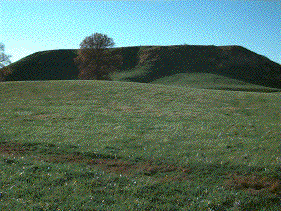
CAHOKIA
"MONK'S MOUND"

VIEW IN A.D. 1300
Cahokia (Ka-ho-Kia)
(The Mississippian Culture)
"Mound Builders"
The Mississippian Culture
lasted from about 700 until 1700's, after the arrival of European settlers. It
developed primarily in what became the southeastern United States and in the
Mississippi Valley Area. The Mississippian people raised livestock and grew
crops. They built some of the earliest cities in North America.
The largest Mississippian city
was Cahokia, in present-day Illinois. It had a population of nearly 40,000 and
probably had a complex form of government. Monk's Mound, the largest mound in
Cahokia, is bigger at the base than the Great Pyramid of Egypt.
"Monks Mound" rises
about 100 feet(30 meters) and covers about 16 acres (6 hectares). Cahokia had
more than 100 other mounds. Many were burial mounds, and others served as
foundations for temples or for the houses of city officials.
The Mississippian people
adopted many customs from the Indians of what is now Mexico, with whom they may
have traded. Like the Mexican Indians, the Mississippian group built large,
flat-topped temple mounds in the center of their cities. At the top of each
mound stood one or more temples, where religious ceremonies were held. Temple
mounds still stand in many cities, including Moundville, Alabama; Macon,
Georgia; and Winterville,Mississippi.
Many southern Mississippian
peoples practiced a religion that anthropologists call the Southern Cult. This
cult borrowed many customs and symbols from Mexican Indian religions. For
example, much Southern Cult artwork includes a flying human figure with
wing-like tattoos around the eyes. Artists also decorated many articles with
spiders and woodpeckers, which they believed had special powers. The Indians
probably practiced human sacrifice as part of the religion.
The Mississippian civilization
continued to grow until the 1500's, when diseases brought by the European
explorers killed many of the people. Only one Mississippian group, the Natchez
Indians, survived long enough to be fully described by the Europeans.

TODAY'S VIEW OF CAHOKIA